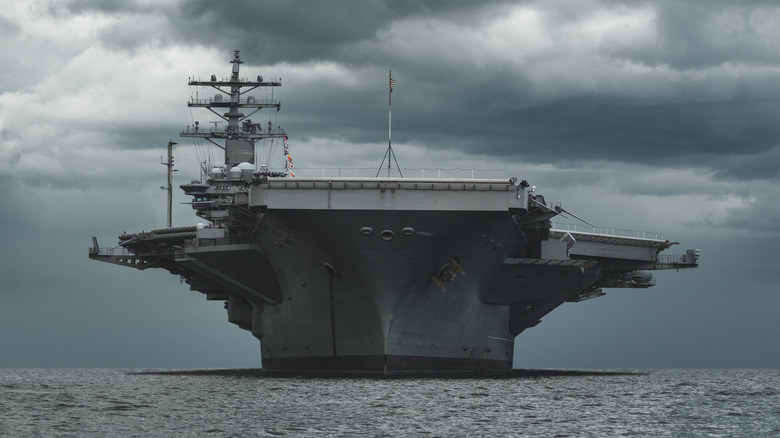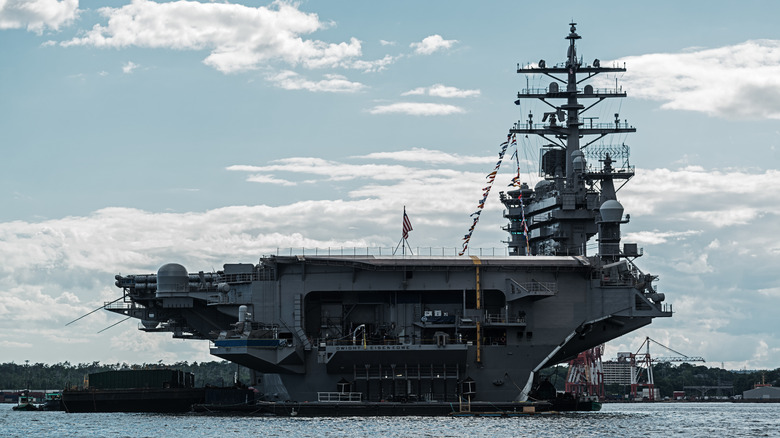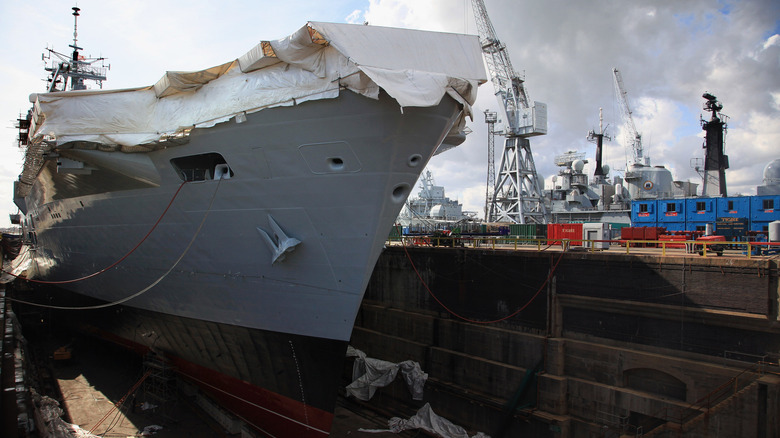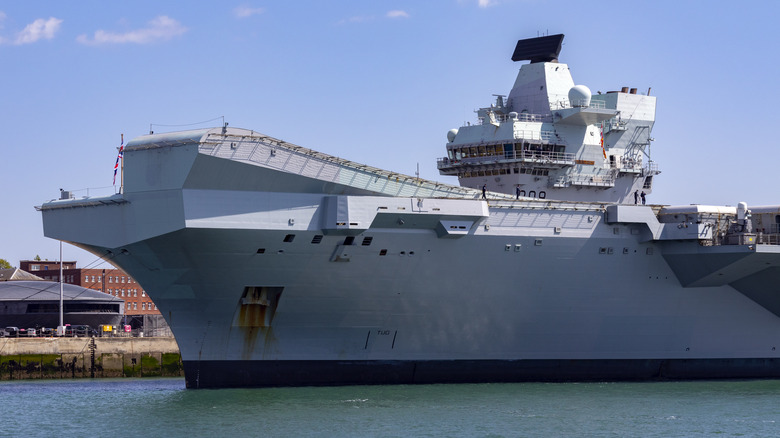How Long Can An Aircraft Carrier Stay At Sea Without Refueling?
Aircraft carriers are essentially massive floating military bases that house over 3,000 individuals. Besides its crewmembers, aircraft carriers also have enough space to store some of the most fearsome fighter jets ever built, along with a runway or two so that planes can take off in the middle of the ocean. Carriers travel all around the world performing a variety of missions, from maritime security to humanitarian support. The world is a big place, and with the size of a single aircraft carrier, one would think they have to pull into port to refuel quite frequently. Well, not quite.
Modern carriers like the USS Nimitz (CVN-68), the oldest aircraft carrier still in service, run on nuclear power. Shortly after Oppenheimer and his team learned how to harness nuclear power as a weapon in Los Alamos, New Mexico, the United States government turned its efforts to other applications. The 1950s saw the emergence of nuclear-powered electricity in Shippingport, Pennsylvania. Naturally, as the technology improved, the new nuclear power tech found its way back to military applications and is now used to power submarines and aircraft carriers.
Thanks to nuclear power, nuclear aircraft carriers, denoted by the CVN hull classification, can stay at sea for nearly 30 years or more without needing to refuel. However, nuclear carriers tend to refuel closer to the 20 year mark. Of course, they dock at ports more frequently than that because the crew needs provisions, and military tours don't last nearly that long.
Why aircraft carriers don't need to refuel often
Contrary to popular belief, nuclear power plants don't release any harmful gases into the atmosphere. In fact, they do not produce carbon emissions, with the only gas released from their large shafts being water vapor or steam. Nuclear reactors use the heat from a nuclear core to create high-pressure steam. On a nuclear aircraft carrier, this steam travels through large propulsion turbines that power the 22-foot propellers. The steam also travels through separate turbines that produce electricity for the rest of the ship. Since it's a closed-circuit system, the same water is reused repeatedly for years until the core is too radioactive to be considered safe for the crew.
Older aircraft carriers had to refuel much more frequently than modern nuclear carriers because they were powered by diesel engines. Diesel engines have benefits over nuclear energy, such as lower costs and being comparatively better for the environment in the long run because nuclear waste can be harmful for thousands of years. However, since diesel fuel is burned and expended into the atmosphere to produce propulsion, unlike the pressurized circuit system nuclear power uses, carriers need to pull into ports more often to refuel.
Refueling and complex overhaul process
Refueling a nuclear aircraft carrier isn't the same as refueling a car or even a fighter jet. It's a more complex process that's referred to as refueling complex overhaul (RCOH). An RCOH can be a two or even three-year process, depending on the extent of the work that needs to be done. In the instance of the USS George Washington (CVN 73), every inch of the ship was updated and repaired, including the main mast.
Firstly, the carrier pulls into a dry dock where the water is completely drained to give engineers a good look at the entire hull. They'll take this opportunity to conduct necessary repairs and updates. Most Nimitz-class carriers have been working with technology that was only available 20 years ago, so refueling is the ideal opportunity to bring those ships up to date. Older computer consoles are replaced with newer ones, and old analog electrical components are replaced with digital ones, modernizing the entire vessel.
Specifically, refueling a nuclear carrier requires dismantling the old reactor's core, which is comprised of numerous rods, and replacing it with a fresh one. Removal isn't limited to just the core, either. The internal surfaces and coolant water are also at critical radioactive levels and need to be replaced. It's such an extensive process that planning alone can take five or more years. During the RCOH, numerous tests will be conducted to ensure all the upgrades and new reactors are working as intended.
What about gas-turbine carriers?
The United States no longer uses gas-powered aircraft carriers, as all of its carriers run on nuclear power. The only other country to have nuclear-powered carriers is France. However, other countries like the United Kingdom, Russia, and China still use gas turbines in their carriers.
England's HMS Queen Elizabeth has a range of 10K nautical miles, so it needs to refuel whenever it nears that distance. Unlike pulling a car into a gas station, the English Navy doesn't need to pull into port every time it needs to refuel. Instead, they perform a maneuver called replenishment at sea, where a tanker sails 138 feet beside the carrier and passes fuel lines across for refueling.
Russia, on the other hand, technically has zero aircraft carriers in its entire naval fleet, as its only "aircraft cruiser" has been undergoing repairs since 2017. That carrier runs on a substance called Mazut, a tar-like low-quality fuel oil. Running on Mazut requires it to refuel every 3,850 nautical miles. China's new flagship carrier, the Fujian, is one of three carriers in its fleet and the newest. The country has kept specific details about the Fujian fairly close to its chest as there are no details about its maximum range. However, according to reporting, Fujian can't travel far for long periods since the country's fleet is limited and lacks a larger replenishment fleet to support long deployments.



